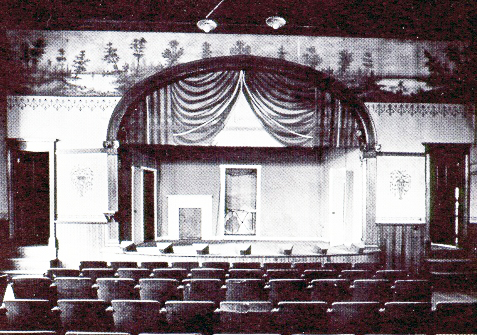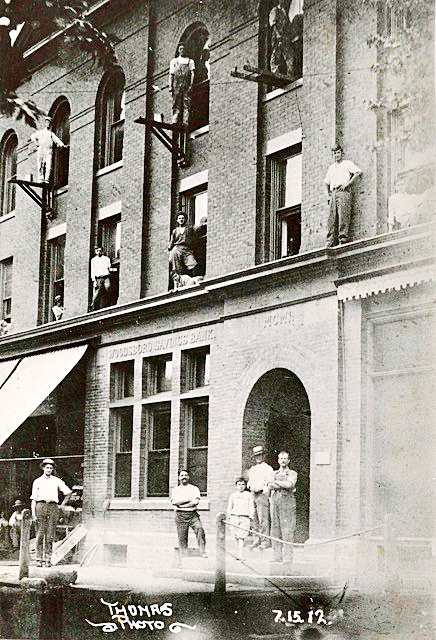
BusinessesPast...
by Richard D. L. Fulton
Woodsboro Opera House
The Woodsboro Opera House existed at 5 North Main Street in Woodsboro, located on the second floor of the building that had been constructed and occupied by the Woodsboro (Savings) Bank.
The structure housing the opera house had replaced a pre-existing structure, which had served as the first location of the then-fledgling Woodsboro (Savings) Bank, demolished by mid-1901. During the demolition, the bank had operated out of other locations while awaiting completion of the new building.
The (Frederick) News reported on September 21, 1901, that the as-yet-to-be completed building would occupy a frontage of 67 feet, with a depth of 64 feet, to be comprised of three stories, noting further that the bank would occupy the first floor and that the second floor would contain an 88-foot by 64-foot hall that would be “suitable for public meetings and amusement purposes.” This “hall” certainly became the then-future location of the Woodsboro Opera House.
The new building was likely completed and occupied in 1902, The (Frederick) News having reported on September 15, 1902, that a stand had been erected in front of the back building, in order to allow the public to attend a band concert.
The first mention of the Woodsboro Opera House occurred in the November 2, 1905, edition of the Catoctin Clarion, which noted that a Democratic Party rally was scheduled to be held there. Subsequently, a good number of political rallies held their events at the opera house.
Soon, other social organizations began holding their regular meetings at the opera house, including such groups as the Woodsboro Literary Society.
The first mention of performing arts having occurred at the opera house was reported in the February 9, 1906, edition of The (Frederick) Citizen, which stated that the Biograph Motion Picture Company (BMPC) held a viewing. BMPC was the first US-based company to focus on film production and exhibition.
Notations of what must have been many theatrical presentations at the opera house have proven to have been few and far between in the old newspapers, so the few should be considered typical of that which was then occurring.
The first, actually identified opera having been “Down on the Farm,” was performed by the Woodsboro Dramatic Company, in April 1908, The (Frederick) Daily News had reported on April 11, 1908.
On February 22, 1912, two plays, “drills,” dances and “recitations” were presented at the opera house under the auspices of Miss Grace Dorcus (an early 20th century actress), according to The (Frederick) News.
A play entitled “Farm Folks” was presented at the opera house by the Woodsboro Dramatic Company on January 12, 1916, while one of the first reel-motion picture movies noted in the media was the showing of a documentary film regarding the suffering of Armenians, which was shown on August 12, 1920.
During the 1930s and 1940s, the opera house was continually used by various organizations for their meetings, for dinners and dances, motion picture presentations, and for theatrical plays.
A newsworthy, non-theatrical event to have occurred at the opera house took place on April 10, 1915, when it had initially appeared that the opera house building had been struck by lightning during a thunderstorm, a report of which had been published on April 16 in The (Frederick) Citizen.
According to the newspaper, “The yell of ‘fire’ coming from a youngster who poked his head in the door of the Woodsboro Opera House, caused a panic there… in which several women went into hysteria, and many persons narrowly escaped serious injuries in the headlong rush down a flight of stairs to gain the open air.”
In conclusion, the newspaper reported, “Finally, when all had gained the street, they discovered that the fire was not in the opera house building, but that the hayshed on the farm of James A. Smith… was ablaze (a quarter-of-a-mile away).”
There was no mention of the outcoming fate of the individual who had caused the panic.
The Woodsboro Opera House ceased operation in 1953. The reason that had been given for its closing was concerns over—ironically—fire safety.

Interior photo of the Woodsboro Opera House.

Woodsboro Bank, as it appeared in 1912.
